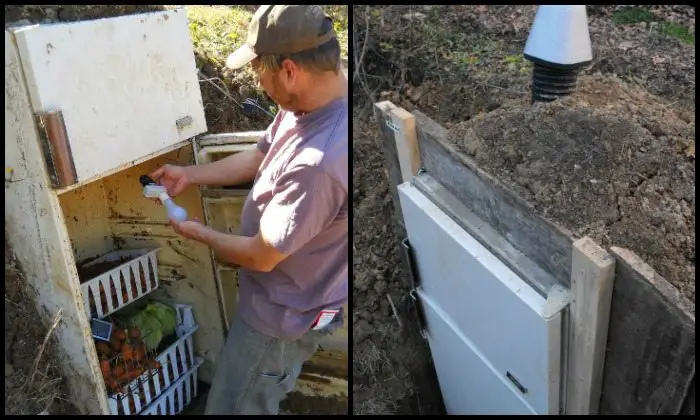Running out of storage for your produce? If you harvest an abundant amount of root vegetables like potatoes and carrots and/or fruits like apples, making a root cellar with an old refrigerator is a simple, yet effective, storage solution.
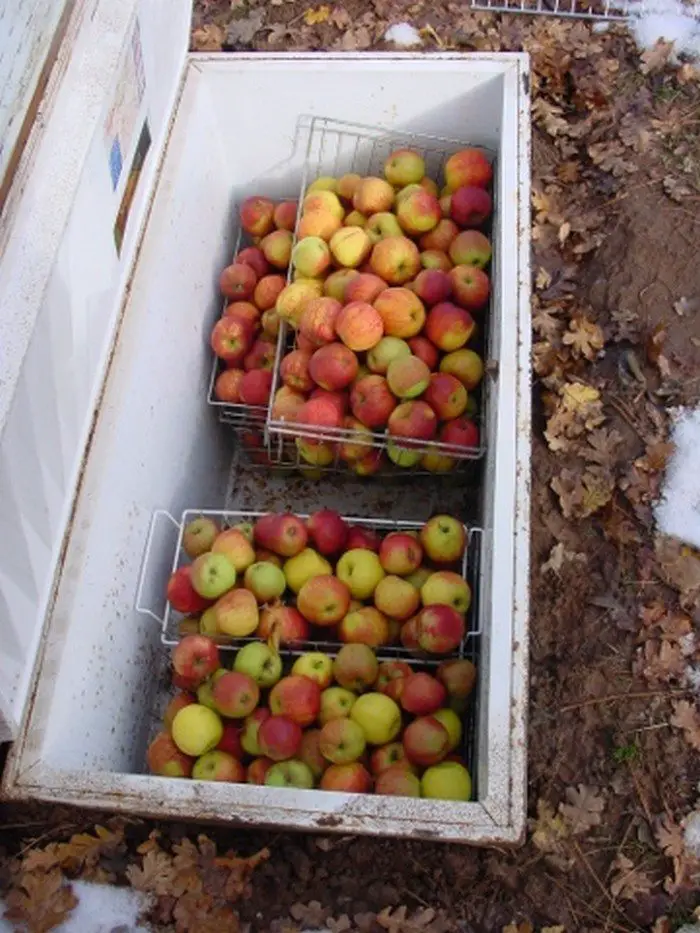
Root cellars are one of the earliest food storage methods And today, the concept is still used together with the other modern ways of storing food like refrigerators and freezers. You can build a root cellar with earthbags, concrete blocks and timber. However that would be a full-blown construction project, requiring quite a large space in your yard.
If you are looking for something less costly and relatively faster and easier to make, you can recycle an old and useless refrigerator or chest freezer. It’s perfect for gardeners with a relatively small garden and an abundant produce needing extra storage!
Do you need this in your yard? View our album to see more of this idea and head over to a step-by-step guide from The Walden Effect through the link below!
Note: Please be mindful of refrigerator safety protocols. Never use a fridge or freezer that can’t be opened from the inside.
Contents
Upcycling an Old Refrigerator into a Root Cellar
Materials
- Old Refrigerator (or Chest Freezer)
- Plastic Food Baskets
- 2×4 Timber
- Scrap Wood
- 4 Cinder Blocks
- Foam Faucet Cover
- PVC Pipe
- Screen (for keeping bugs out)
- Screws and Nails
Tools
- Shovel
- Jigsaw
- Drill
- Hammer
- Post Hole Digger
Instructions
Step 1: Preparation
- Location: Choose a shaded, cool location in your yard that remains consistent in temperature. Avoid areas that collect a lot of water.
- Safety Check: Ensure the refrigerator can be opened from the inside to prevent accidents.
Step 2: Excavation
- Digging: Use the shovel and post hole digger to excavate a pit slightly larger than the refrigerator. The depth should allow the refrigerator to sit with its top flush with or slightly below the ground level.
Step 3: Foundation Setting
- Cinder Blocks: Place cinder blocks at the bottom of the dug pit to create a stable and level foundation for the refrigerator. This helps in drainage and prevents direct contact with soil which can lead to rusting.
Step 4: Modify the Refrigerator
- Ventilation: Using the jigsaw, cut two small holes: one near the top and one at the bottom of the refrigerator for air circulation. Cover these holes with screens to keep bugs out.
- Door Removal: Remove the refrigerator door and replace it with a custom door made from 2×4 timber and scrap wood for better insulation. Secure with hinges.
Step 5: Insulation
- Faucet Cover: Use foam faucet covers around the ventilation holes to prevent drafts while still allowing air flow.
- Surround Insulation: Pack earth around the sides of the refrigerator once it is placed in the pit to add natural insulation.
Step 6: Installation
- Positioning: Lower the refrigerator into the pit onto the cinder block foundation.
- Secure: Use screws and nails to attach any additional wooden supports or modifications to ensure stability and security.
Step 7: Plumbing
- Drainage: Install PVC pipes leading from the bottom of the refrigerator to ensure proper drainage and prevent water accumulation.
Step 8: Interior Setup
- Baskets: Place plastic food baskets inside the refrigerator for organized storage. These baskets allow for better air circulation around the stored produce.
Step 9: Final Touches
- Check: Double-check all modifications for security and efficiency. Make sure the door seals well to maintain the internal temperature.
- Test: Before storing any produce, monitor the temperature and humidity for a few days to ensure the environment is stable and suitable for storage.
Click on any image to start lightbox display. Use your Esc key to close the lightbox.![]()
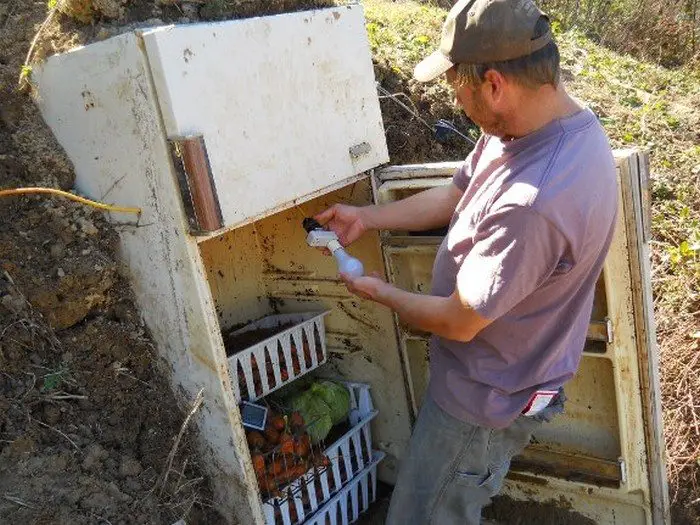
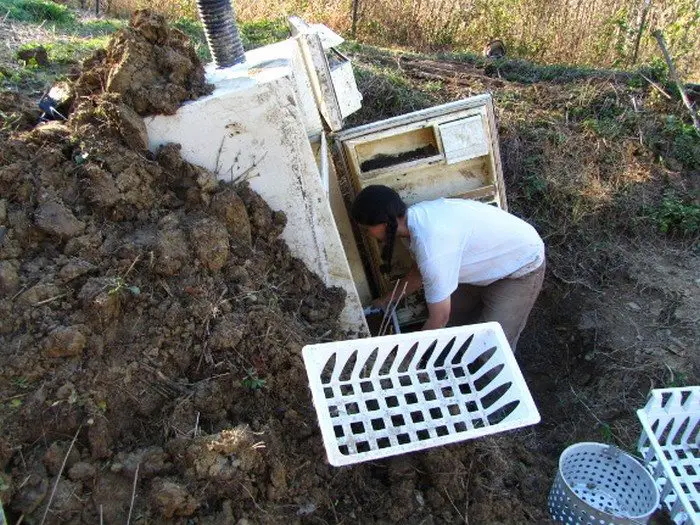

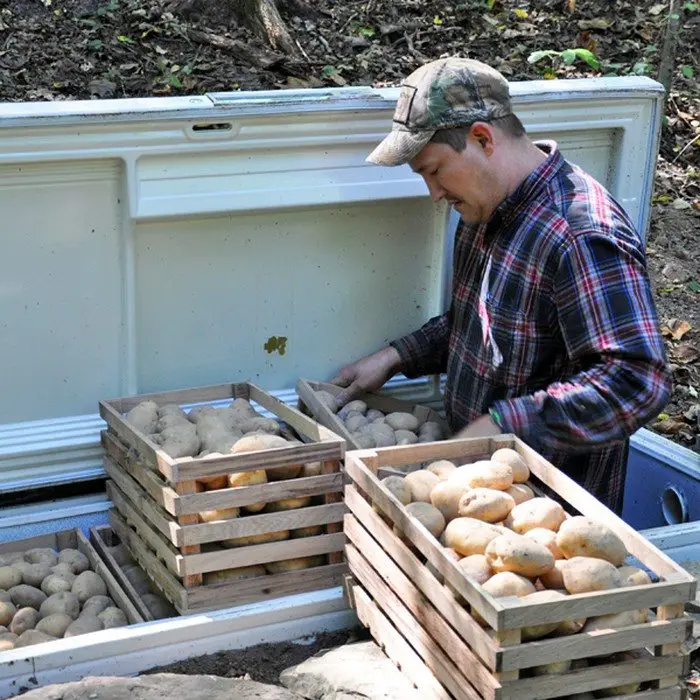
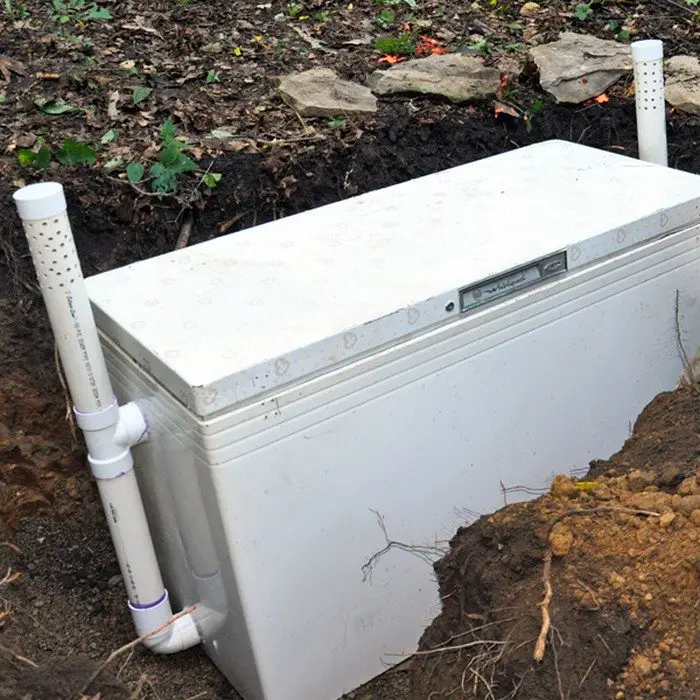

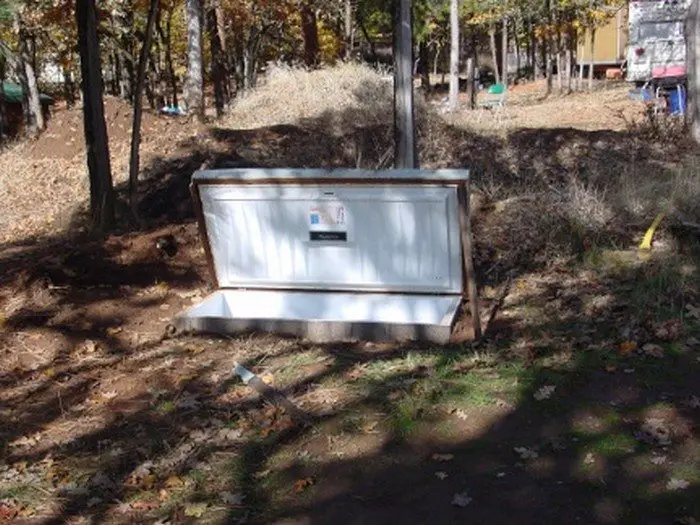
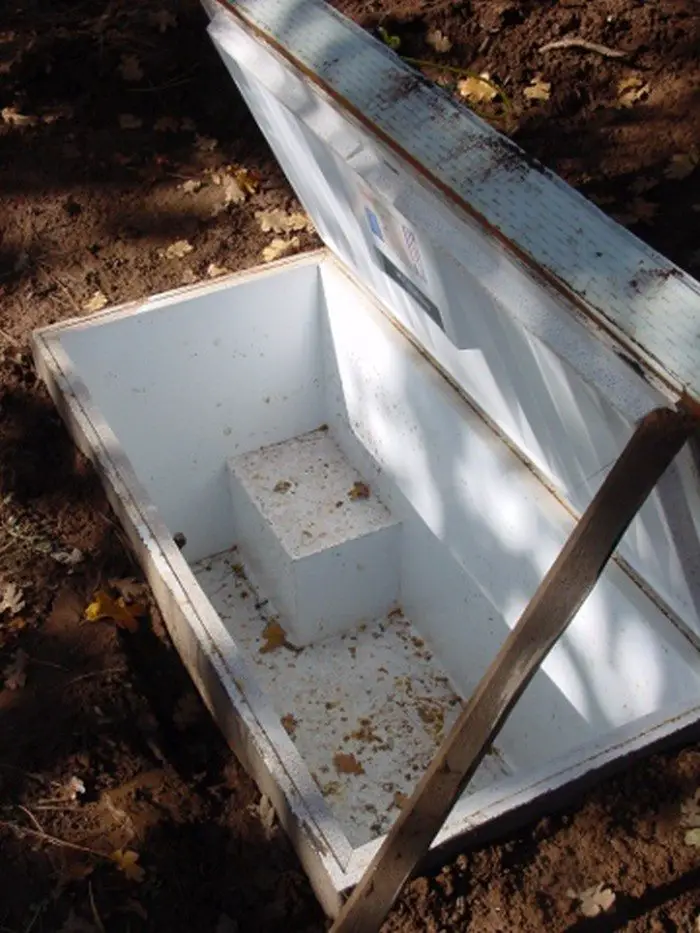




You can get more step-by-step instructions from The Walden Effect over here…
Benefits of Using a Root Cellar
For generations, food has been preserved in the same way—root cellars—especially in areas with seasonal temperatures. Root cellars are the perfect place to keep fruits, vegetables, and other perishables since they take use of the naturally damp and chilly conditions underneath. Use of a root cellar has the following main advantages:
Natural Preservation
Root cellars use the earth’s natural cool temperature and humidity to preserve food. This method is particularly effective for storing root vegetables like potatoes, carrots, and beets, as well as other perishables like apples and cabbage. The cool conditions slow down the decay process, while the moisture level prevents produce from drying out, extending the shelf life of foods for months.
Energy Efficiency
Because a root cellar doesn’t use power, unlike contemporary refrigeration systems, it’s a more environmentally benign choice. This lowers energy bills and lessens your carbon footprint. Root cellars provide environmentally concerned people a workable answer in a time when sustainability is becoming more and more vital.
Cost-Effectiveness
When you use salvaged materials like old freezers or construction scraps, building a root cellar may be a reasonably priced undertaking. Once built, a root cellar requires little upkeep and offers a free storage option that reduces food preservation-related family costs year after year.
Emergency Preparedness
Having a root cellar offers a safe and dependable non-electric food storage space during power outages or natural calamities. It is thus a great choice for emergency preparedness since it guarantees that you will always have fresh vegetables available, no matter what the weather.
Increased Storage Space
A root cellar increases storage capacity dramatically for people who either cultivate their own food or buy in bulk. Large amounts of seasonally appropriate vegetables can be stored for use all year round, which lowers waste and shopping trips.
Enhances Flavor and Texture
When kept in a root cellar, some foods—like apples and cabbages—can get richer flavors. Rarely can alternative storage techniques match the maturation process that is facilitated by the cool, humid environment, which over time improves taste and texture.
Root cellars combine conventional wisdom with contemporary demands to provide a cost-effective and ecological way to preserve food. A root cellar can be an invaluable addition to your house whether you’re a homesteader, gardener, or just trying to lessen your environmental effect.
Safety Considerations and Best Practices
While an old freezer are great as cellars for growing vegetables, your safety should also be considered. These includes keeping pests out and choosing the right vegetables or fruits to store. .
Below are several safety tips to keep in mind.
Proper Ventilation
In order to maintain a balanced interior environment and avoid the accumulation of ethylene gas, which may quickly deteriorate stored crops like apples, a root cellar must have adequate ventilation.
Good air exchange lowers the chance of mold and mildew by eliminating excess moisture and assisting in temperature regulation. Install vents thoughtfully at the cellar’s lowest and highest locations to accomplish this. A natural airflow that preserves ideal storage conditions is created by the upper vent allowing warmer air to exit and the lower vent allowing cooler air to enter.
In order to maintain the proper temperature and humidity levels in your root cellar all year round, think about installing adjustable vents to regulate the airflow during the various seasons.
Secure Door Mechanisms
The door mechanisms of an old refrigerator or freezer must be carefully modified if you want to use it as a root cellar. If the original locking mechanism cannot be readily unlocked from the inside, it must be replaced or retrofitted. This modification is essential for avoiding unintentional lock-ins, which may be extremely hazardous for kids or during crises.
Install a basic, dependable internal release mechanism that is easily accessible and user-friendly, such a pull cord or push button. A viewing glass or an inside light that turns on automatically when the door is opened could be included as an additional safety element to improve visibility and safety for everyone within.
Regular Maintenance Checks
The longevity and usefulness of your root cellar depend on maintaining its structural integrity. To spot and take care of any early indicators of deterioration, such rust on metal parts or decay in wooden buildings, routine inspections are required. A well sealed door is essential for preserving the internal climate control, keeping out pests, and guaranteeing that the product being stored stays in good condition. Pay close attention to the door and its seals.
Pest Control Measures
Install screens on vents and ensure all seals are tight to prevent insects and rodents from entering the cellar. These pests can damage your stored food and pose health risks.
Correct Use of Materials
If you’re adding extra insulation to your cellar, use materials that are moisture-resistant and designed for underground use. Avoid materials that could mold or degrade, potentially contaminating your food.
Moisture and Mold Management
Too much humidity can lead to mold growth, while too little can cause dehydration of stored goods. Use a hygrometer to monitor humidity levels and adjust ventilation or use moisture absorbers to maintain an optimal environment.
Emergency Preparedness
In case of emergencies, ensure that your root cellar can be accessed quickly and safely. Keep a path clear and have a reliable lighting source available to navigate the cellar safely during power outages or other emergencies.
Following these safety considerations and best practices will help you maintain a safe and effective root cellar, ensuring that your stored food remains fresh and your family stays safe.
Conclusion
Repurposing an old refrigerator to create a root cellar is an economical and environmentally friendly method of extending the life of your produce. This DIY technique utilizes the earth’s natural cooling capabilities to effectively store food, providing a year-round, ecologically responsible way to manage your crops.

